Intel's Ivy Bridge Architecture Exposed
by Anand Lal Shimpi on September 17, 2011 2:00 AM EST- Posted in
- CPUs
- Intel
- Ivy Bridge
- IDF 2011
- Trade Shows
The New GPU
Westmere marked a change in the way Intel approached integrated graphics. The GPU was moved onto the CPU package and used an n-1 manufacturing process (45nm when the CPU was 32nm). Performance improved but it still wasn't exactly what we'd call acceptable.
Sandy Bridge brought a completely redesigned GPU core onto the processor die itself. As a co-resident of the CPU, the GPU was treated as somewhat of an equal - both processors were built on the same 32nm process.
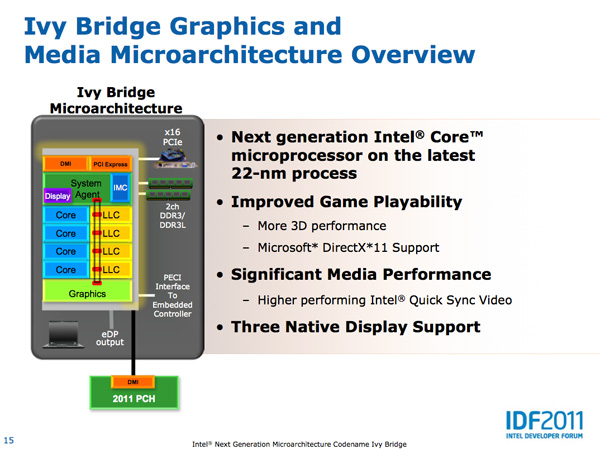
With Ivy Bridge the GPU remains on die but it grows more than the CPU does this generation. Intel isn't disclosing the die split but there are more execution units this round (16 up from 12 in SNB) so it would appear as if the GPU occupies a greater percentage of the die than it did last generation. It's not near a 50/50 split yet, but it's continued indication that Intel is taking GPU performance seriously.
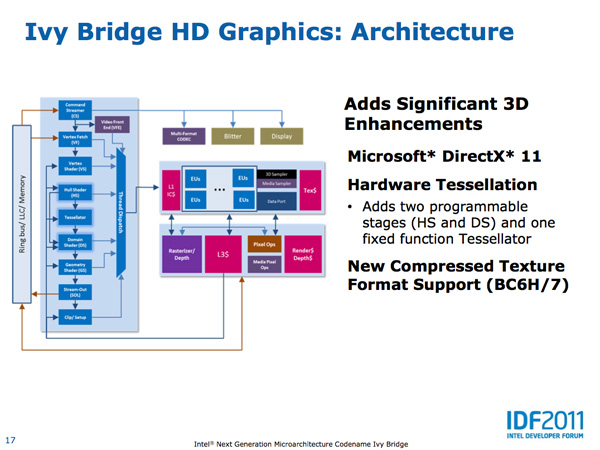
The Ivy Bridge GPU adds support for OpenCL 1.1, DirectX 11 and OpenGL 3.1. This will finally bring Intel's GPU feature set on par with AMD's. Ivy also adds three display outputs (up from two in Sandy Bridge). Finally, Ivy Bridge improves anisotropic filtering quality. As Intel Fellow Tom Piazza put it, "we now draw circles instead of flower petals" referring to image output from the famous AF tester.
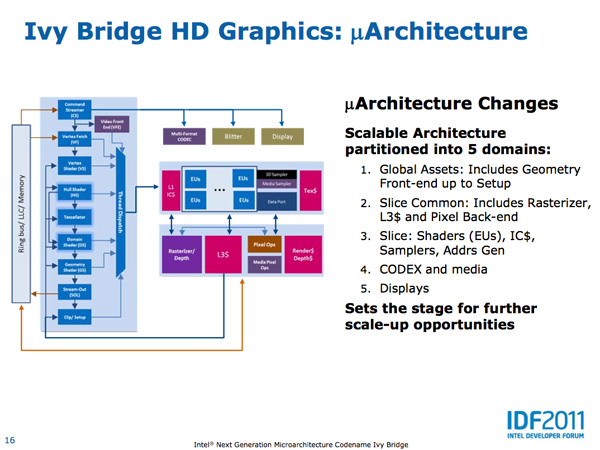
Intel made the Ivy Bridge GPU more modular than before. In SNB there were two GPU configurations: GT1 and GT2. Sandy Bridge's GT1 had 6 EUs (shaders/cores/execution units) while GT2 had 12 EUs, both configurations had one texture sampler. Ivy Bridge was designed to scale up and down more easily. GT2 has 16 EUs and 2 texture samplers, while GT1 has an unknown number of EUs (I'd assume 8) and 1 texture sampler.
I mentioned that Ivy Bridge was designed to scale up, unfortunately that upwards scaling won't be happening in IVB - GT2 will be the fastest configuration available. The implication is that Intel had plans for IVB with a beefier GPU but it didn't make the cut. Perhaps we will see that change in Haswell.
As we've already mentioned, Intel is increasing the number of EUs in Ivy Bridge however these EUs are much better performers than their predecessors. Sandy Bridge's EUs could co-issue MADs and transcendental operations, Ivy Bridge can do twice as many MADs per clock. As a result, a single Ivy Bridge EU gets close to twice the IPC of a Sandy Bridge EU - in other words, you're looking at nearly 2x the GFLOPS in shader bound operations as Sandy Bridge per EU. Combine that with more EUs in Ivy Bridge and this is where the bulk of the up-to-60% increase in GPU performance comes from.
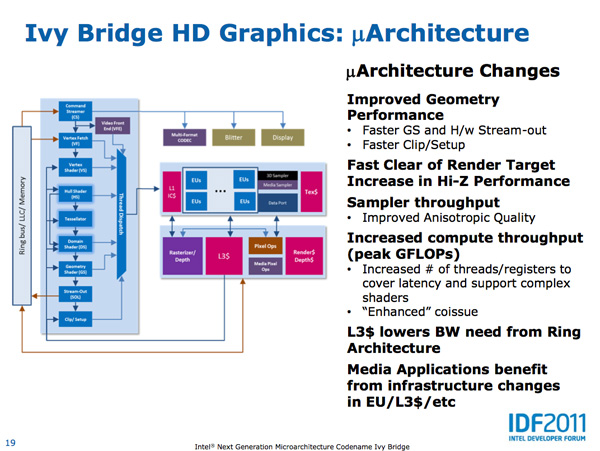
Intel also added a graphics-specific L3 cache within Ivy Bridge. Despite being able to share the CPU's L3 cache, a smaller cache located within the graphics core allows frequently accessed data to be accessed without firing up the ring bus.
There are other performance enhancements within the shader core. Scatter & gather operations now execute 32x faster than Sandy Bridge, which has implications for both GPU compute and general 3D gaming performance.
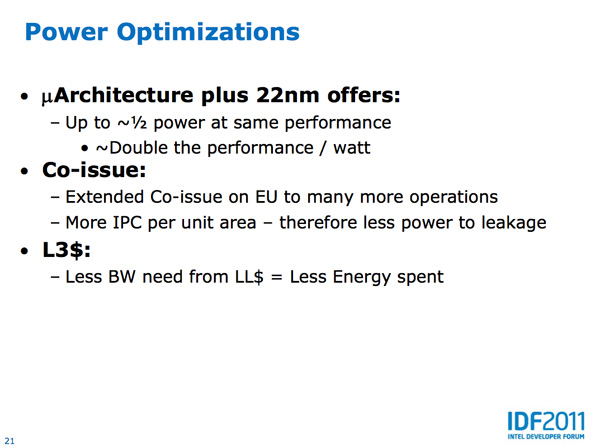
Despite the focus on performance, Intel actually reduced the GPU clock in Ivy Bridge. It now runs at up to 95% of the SNB GPU clock, at a lower voltage, while offering much higher performance. Thanks primarily to Intel's 22nm process (the aforementioned architectural improvements help as well), GPU performance per watt nearly doubles over Sandy Bridge. In our Llano review we found that AMD delivered much longer battery life in games (nearly 2x SNB) - Ivy Bridge should be able to help address this.
Quick Sync Performance Improved
With Sandy Bridge Intel introduced an extremely high performing hardware video transcode engine called Quick Sync. The solution ended up delivering the best combination of image quality and performance of any available hardware accelerated transcoding options from AMD, Intel and NVIDIA. Quick Sync leverages a combination of fixed function hardware, IVB's video decode engine and the EU array.
The increase in EUs and improvements to their throughput both contribute to increases in Quick Sync transcoding performance. Presumably Intel has also done some work on the decode side as well, which is actually one of the reasons Sandy Bridge was so fast at transcoding video. The combination of all of this results in up to 2x the video transcoding performance of Sandy Bridge. There's also the option of seeing less of a performance increase but delivering better image quality.
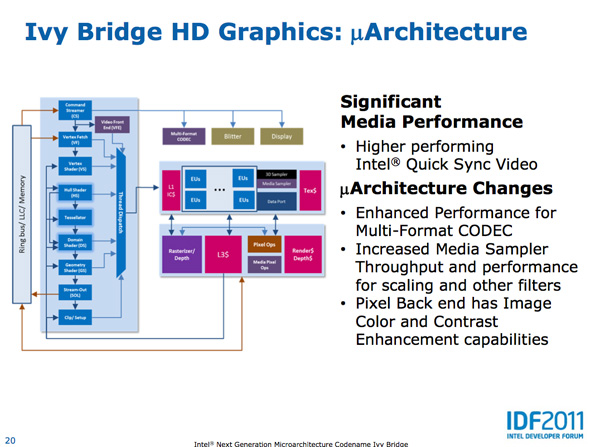
I've complained in the past about the lack of free transcoding applications (e.g. Handbrake, x264) that support Quick Sync. I suspect things will be better upon Ivy Bridge's arrival.
















97 Comments
View All Comments
medi01 - Sunday, September 18, 2011 - link
It's been a while that most users didn't really need faster CPUs or GPUs.In a couple of years, why on earth would anyone but gamers need a PC? Emails, browsing, video would be covered by tablets and the likes.
dealcorn - Friday, November 4, 2011 - link
My Suzuki Alto has about the horsepower of a team of mules and it's fine, really. However, if for about the same money and fuel economy I could get 600 hp, darn right I need 600 hp. That's about where we are at with CPU power. I believe your issue is more properly stated as "there is a need to re engineer humanity because it is not doing what I want."Billy_Boy - Saturday, September 17, 2011 - link
"In Sandy Bridge, many of those structures are statically partitioned. If you have a buffer that can hold 20 entries, each thread gets up to 10 entries in the buffer. In the event of a single threaded workload, half of the buffer goes unused."If you turn off HT does this go away in Sandy Bridge?
BioTurboNick - Saturday, September 17, 2011 - link
They are talking about a hardware implementation, so it wouldn't go away by disabling hyper-threading.Zoomer - Saturday, September 17, 2011 - link
It depends if the designers thought it would be important enough to implement. Losing 1/2 of the many resources (though probably not execution resources) is huge, and on a non-HT chip it's almost like castrating it.BioTurboNick - Saturday, September 17, 2011 - link
Right. That's probably why Ivy Bridge is moving to completely single-thread-capable resources.danjw - Saturday, September 17, 2011 - link
I am wondering if Ivy Bridge will be faster for gaming then the Sandy Bridge-E. I lot of the improvements seem to be with threading, but more games are starting to implement threading. Sandy Bridge-E will have PCI-Express 3.0 and more memory channels, but Ivy Bridge will have faster memory.Hrel - Saturday, September 17, 2011 - link
Will Intel FINALLY be turning on hyper threading on every CPU? Cause if not that's the final straw that breaks the camels back, I'm going AMD. It took them years to finally get a decent quad core down to 200 bucks, but then if you wanted HT it cost another 100 bucks. Ridiculous. I want to be able to buy a K series quad core with HT for under 200 bucks. Also WHY are there USB 2.0 ports on this AT ALL?If AMD has all usb 3.0 ports and the CPU performance is comparable I'm def switching camps.
Do you guys know if AMD has any plans on releasing SSD caching on their motherboards too? Cause that really is a "killer app" so to speak. Large SSD's are too expensive to make any sense unless you're filthy rich but 64GB with two 2TB HDD's in RAID sounds pretty great.
philosofool - Saturday, September 17, 2011 - link
When AMD releases serious competitors at the relevant price points. I hope bulldozer kicks ass, because a solid quad core will be two hundred bucks until there is real competition.medi01 - Sunday, September 18, 2011 - link
If you count motherboard price in, AMD is already more than competitive.